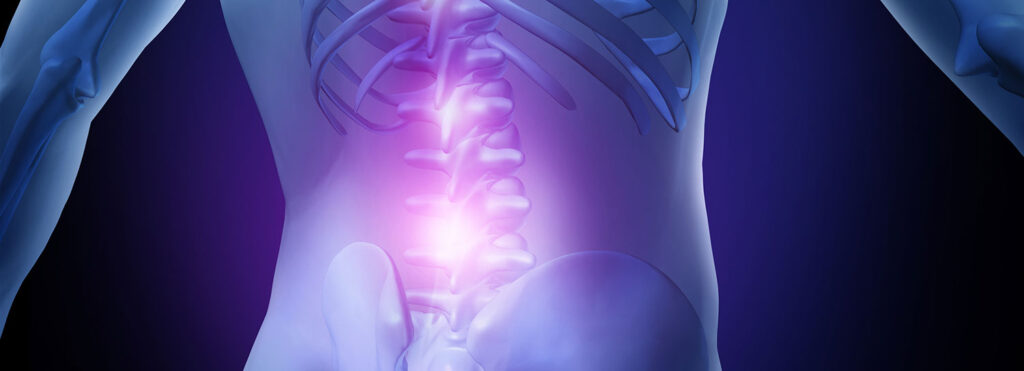Treatment for Back Pain

Back pain effects more than 85% of all Americans during their lifetime. It can have many causes such as disc, joint, ligament/bone or muscular pathology. Acute pain (less than six weeks onset) is usually self-limited. Immediate medical attention should be sought when weakness, loss of sensation, or bladder/bowel changes accompany the pain. While acute pain is usually recognized as only lasting approximately 6 weeks, chronic pain is generally termed after 12 weeks. Most sources of pain respond to conservative treatments, which may include Physical Therapy, Chiropractic Care, anti-inflammatory medications, topical pain relievers and cortisone injections. Unfortunately, there is a subset of people whose pain is so severe that activities or work are extremely limited during the first six weeks. Or, the pain extends beyond six weeks and approaches the chronic stages of a condition. For these groups of patients, many will respond to interventional pain procedures.
There is no blood test for pain. The diagnosis and treatment require the performance of a careful history and physical exam, along with the use of radiographs (X-Ray, MRI, CT). EMG and nerve conduction studies may also be indicated.
Common causes of back pain include: Lumbar Disc Bulge, Lumbar Disc Herniation, Degenerative Disc Disease, Joint Inflammation (both facet and sacroiliac), Sciatica (pinched nerve), fractures of vertebrae, lumbar spinal stenosis, and prior back surgery (also known as post laminectomy syndrome).
What is degenerative disc disease and what are the symptoms?
Spinal disc degeneration is one of the most common causes of back pain, affecting in particular the lumbar spine (low back). Spinal discs are soft, compressible structures that separate the vertebrae of the spine. The discs act as shock absorbers, allowing the spine to flex, bend, and twist.
Sciatica is the name for the horrible leg pain that is caused when a bulging lumbar disc irritates a lumbar nerve root. The discomfort can be a combination of burning pain and numbness that responds poorly to pain medication.
There is a normal amount of expected wear and tear of our spinal discs as we age. On the other hand, arthritis, injury, and extreme wear and tear of sports can accelerate the degeneration. On a cellular level, there is continual loss of healthy cells inside the disc that is responsible for the disc’s structure. Over time, normal cells are damaged and hydration is lost, leading to tears in the internal structure of the discs.
When discs degenerate, mobility is affected and function is limited, resulting in symptoms that include stiffness, weakness, and ultimately, unrelenting pain.
What is spinal facet disease and what are the symptoms?
Spinal facet disease is one of the most common causes of neck and back pain and can cause pain at any level of the spine. The spinal facets joints are located on both sides of the back of each spinal segment. They connect each spinal level and are responsible for stabilizing the vertebral bodies and counterbalancing the intervertebral discs. The facets can be injured during acute trauma often seen in flexion extension injuries such as a whiplash event or sports accident. The surfaces of the facet joints are covered by articular cartilage and are also prone to chronic degenerative arthritis much like the larger joints such as knees and hips.
Pain that is caused by facet dysfunction is typically isolated to the back of the lumbar spine, thoracic region and neck. The discomfort can be isolated to one side or may affect both sides of the spine at once. The pain may radiate into the muscles but does not extend into the extremities like sciatic pain that is caused from a disc herniation. Typically the pain is worsened with extension and or rotation of the neck or back. Diagnosis of facet pain begins with a physical exam and imaging studies, but often requires diagnostic injection with local anesthetic and or steroid to confirm the diagnosis.
When the facet joints are injured mobility is affected and function is limited, resulting in symptoms that can mimic disc disease such as stiffness, weakness, and ultimately, unrelenting pain.
Additionally, radiofrequency lesioning can be utilized to maximize pain relief in the facet joints while the joints are undergoing the regenerative healing process.
Intradiscal Injections for Back Pain:
Placement of a needle into the vertebral disc or facet joint is a difficult and potentially dangerous procedure. This procedure should always be carried out under fluoroscopic (real-time x-ray) guidance by a physician highly trained in this technique. This is considered the gold standard for injections of the spine as it provides the highest level of safety.
Contact us
Get in touch






